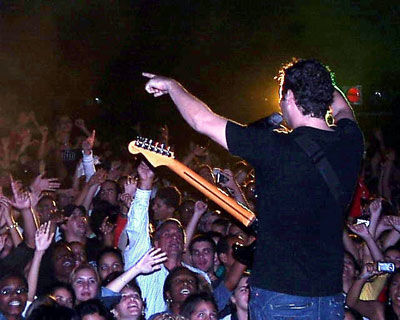12.20.20 Hard Currency

Moneda Dura, a Cuban popular music orchestra, was founded in November 1997 at the University of Havana. Nassiry Lugo is its director and lead singer. They initially rehearsed in a small house in the municipality of Centro Habana, and later at the University (University Avenue and Vedado neighborhood, Plaza de la Revolución, Havana).
Moneda Dura is made up of: Nassiry Lugo Lugo (Director and Lead Vocalist); Michel Lugo Lugo (Percussion and Backing Vocals); Adrián Ginés Sánchez (Drums); Jorge Javier Maletá Sánchez (Keyboards, Programming, Guitar and Backing Vocals); Fernando Liu Tort Chiang (Bass); Saúl Berman Castillo (Guitar); Roque J. García Ledo (Trumpet and Keyboards).
Moneda Dura is a pop-rock group, although its performances fuse various musical genres such as alternative rock, pop, funk, and reggae with Cuban popular music such as son, salsa, and trova; a unique characteristic that constitutes its musical signature.
Most of the songs in Moneda Dura’s repertoire and the arrangements are the work of the band’s director. The themes they address reflect the experiences of Cuban society today, ranging from social criticism to love.
The album Callejero is made up of ballads, guarachero songs, and rock songs. It features guest appearances by two important figures in Cuban music: Ibrahim Ferrer and the Charanga Habanera. It features songs like Callejero, Luna Llena, and Yo vengo de la Habana.
Numerous songs they have performed during their years of existence within the field of Cuban music have been very popular and have enjoyed the preference of the public such as: Without speaking, Lola, Callejero, El Mayor, When Havana sleeps, Mala leche, Los Ojos de Aitana, Ella parece, Ni dulce ni salá, Me quedaré, Ojalá, Luna llena and Al Mediterráneo, among others.
At the beginning of 2008, Moneda Dura undertook a successful national tour sponsored by the Union of Young Communists and the Cuban Institute of Music (452 Calle 15, corner of Calle F, Vedado, Plaza de la Revolución, Havana). During the tour, they filled the plazas of numerous Cuban cities and broadcast the song La Madrugada, the theme song of the 11th Congress of the Federation of Secondary School Students (FEEM). As Nassiry aptly put it, this tour is based on young people and their strength, on a new day dawning for the less experienced generations. They also performed songs from their latest album.
They have performed numerous times in Cuba, including a national tour of Cuban universities sponsored by the Ministry of Higher Education and the Cuban Institute of Music (452 Calle 15, corner of Calle F, Vedado, Plaza de la Revolución, Havana). During this tour, they presented new musical pieces.
Moneda Dura has a very diverse audience, with thousands of people attending their concerts. They are Cuba’s most famous pop rock group, which has earned them top spots on both national and provincial radio charts.
Moneda Dura has participated in important events such as the Gala de la Hispanidad in Spain, where she represented Cuba. She has been nominated for Cubadisco on several occasions.
Discography: When Havana Sleeps (1998), Mucho Cuida’o (2000), Ojalá (2002), Callejero (2004), Alma sin bolsillos (2007).








